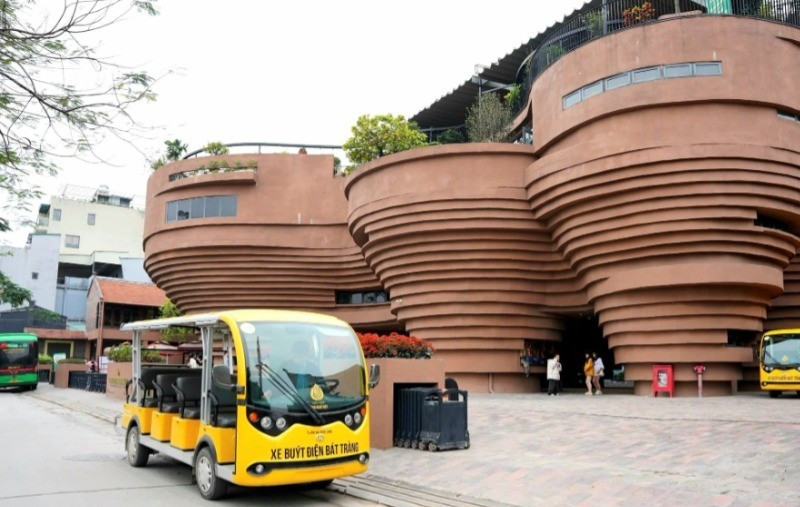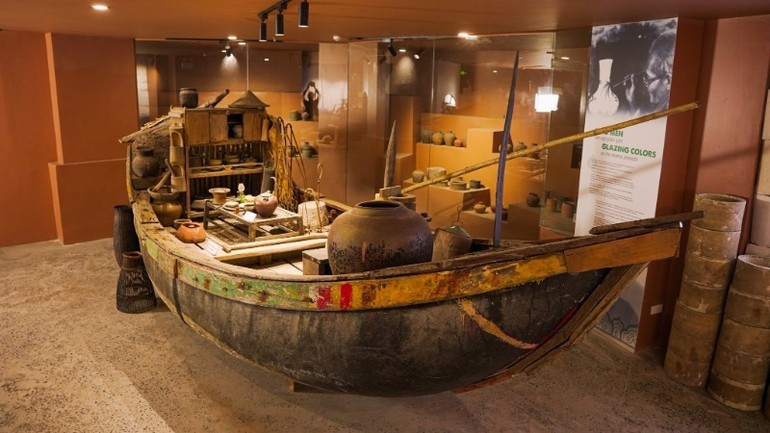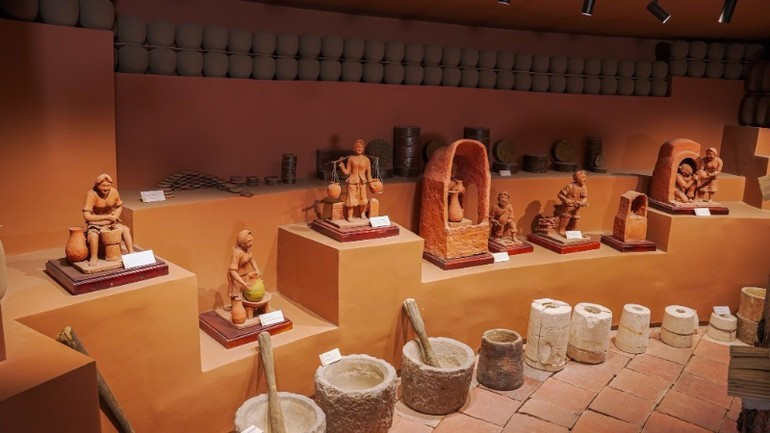
Electric bus routes actively support tourism activities in Bat Trang
Unlike the traditional rural landscapes of the Northern Delta with their lush bamboo groves and paddy fields, Bat Trang’s charm lies in its open spaces by the riverside. In days past, boats laden with ceramics and delicacies from forest and sea plied the waters constantly.
Every house boasts a blazing kiln, and villagers work tirelessly at the potter’s wheel, crafting vases, bowls, plates and more. Bat Trang artisans rely not only on their gifted hands, but also on hearts filled with passion and dedication. The narrow, winding lanes-just wide enough for a single motorbike-remain alive all year round with the rhythm of pottery-making.
Historically, the village’s sturdy brick-and-tile houses form a closely-knit architectural ensemble. Each home features a small tiled courtyard, pots of flowering plants, creating an aesthetic, nature-immersed ambience, typical of a prosperous craft village.
Bat Trang pottery is renowned for its striking appearance and unique glazing techniques. Over time, enamelled jade, brown floral designs and crackle glaze wares have evolved from everyday household items into works of art-imbued with the essence of the Bat Trang artisan.”
Bat Trang stands out not only for its ceramics, but also for its scholarly tradition and reverence for knowledge. The village takes pride in its cultural figures, especially accomplished sages, doctoral laureates and imperial candidates.

The boat recreates the historical journey leading to the founding of Bat Trang craft village
Though the village population was once not large, it produced 364 sages and scholars, including one ‘trang nguyen’ (top imperial graduate), eight ‘tien si’ (doctoral degree holders) and two dukes. The Le lineage alone produced seven high-ranking royal officials. The village even contributed military commanders who achieved victories that brought honour to their homeland.
This spiritually-rich land hosts nine historical and architectural heritage sites, such as Tieu Giao Pagoda, Giang Cao communal hall, Ban shrine, Bat Trang communal hall, Mau temple, Kim Truc pagoda, and the village study hall.
Inside Bat Trang communal hall, 44 royal edicts from successive monarchs and a horizontal plaque proclaiming “Hieu nghia cap cong” (“Filial and righteous deeds honoured”) recall Emperor Tu Duc’s decree for Bat Trang to supply vast quantities of bricks for the construction of the Hue Imperial City and the Nguyen dynasty tombs. The entire village responded with fervent dedication and completed the task with pride.
Every year during the full moon of the second lunar month, villagers hold a traditional festival to celebrate the craft and express gratitude to ancestors and tutelary deities. The ceremony features solemn rites, including a water‑fetching ritual from the Red River to the communal hall, praying for peace and bountiful harvests.
In 2014, Bat Trang’s traditional festival was recognised as a national intangible cultural heritage by the Ministry of Culture, Sports and Tourism.
Thanks to its long history and distinctive features, Bat Trang has become an emblem of Vietnamese pottery and a compelling tourism destination. Local ceramic workshops have been renovated to create viewing and hands-on experience spaces. Visitors can take part in every step of pottery-making, from basic shaping to creating handcrafted pieces.
In particular, at the Centre for Vietnamese Craftsmanship (Bat Trang Ceramic Museum), guests can appreciate striking architecture, beautiful artworks, and learn about the village’s history and artistic evolution. The centre also hosts other traditional crafts-such as light‑sculpture art, conical‑hat weaving, and bamboo‑rattan weaving-with artisans from across Viet Nam collaborating.
Smart‑tourism products continue to be promoted, including bicycle tours like “Footprints of Ancient Bat Trang” and combined tours linking the Thang Long Imperial Citadel with the pottery village—offering visitors the opportunity to explore the rich history entwined with Bat Trang ceramics.
Pham Huy Khoi, Chair of Bat Trang Commune People’s Committee, states that local authorities and villagers actively engage in preserving and developing tourism, investing in infrastructure projects such as upgrading roads, building a tourism wharf and establishing a craft village cluster. These improvements support tourism and help preserve cultural values for future generations.
Since opening in 2004, the Bat Trang ceramic market has grown to over 300 stalls, becoming a favourite destination for those interested in collecting or decorating with handmade ceramics. Launched in June 2022, the Bat Trang Ceramic Museum attracts visitors-especially young people-with its iconic design modelled on clay being shaped on a potter’s wheel. The museum unites artisans from 19 local families, who showcase their passionate craftsmanship, bringing vibrant character to the site.
Beyond visiting the craft village, tourists can savour Bat Trang’s distinctive culinary offerings-traditional dishes that symbolise reunion and connection among community members and guests.
In line with local government encouragement of community-based tourism, artisan Pham Thi Dieu Hoai has repurposed a 300‑year‑old house to host visitors keen to sample these regional dishes—helping to diversify the available services.
Between 2019 and 2020, a ceramic mosaic pathway along the Red River dyke was created by skilled artisans from Giang Cao Village. Residents also painted mural walls, developed “flower‑blooming lanes” and maintained environmental cleanliness to enhance the area’s beauty.

The artworks depict various stages of the pottery-making process
In recent years, tourism in Bat Trang has surged. On average, the village welcomes about 5,000 visitors each weekend-who come to explore, shop and experience the craft. Artisan Ha Thi Vinh, Chair of the Board of the Social Enterprise “Tinh hoa Lang nghe Viet” (Essence of Vietnamese Crafts), notes that the village has piloted content for an ambitious ecotourism project in the ancient village.
Visitors can not only observe the production process, but also actively take part-making pottery, joining in a kiln‑worker’s meal, and more. Every resident can become a tour guide or storyteller; every household is a node in the grand museum of ancestral craft tradition.
Assoc. Prof. Dr Dang Van Bai, former Director of the Department of Cultural Heritage (Ministry of Culture, Sports and Tourism) and Vice‑Chair of the National Council for Cultural Heritage, comments: “Few craft villages with such vitality as Bat Trang remain, and its value lies not just in livelihood, but in knowledge, academic qualifications, cuisine. … It is a community of aspiration, preserving ancestral heritage while forging ahead. Thus tourism must conserve village culture-but not in a freeze-dried way; flexibility brings motivation and enhances community livelihoods.”
Collaborating on the development of Bat Trang’s ecotourism, artist Nguyen Manh Duc emphasises: “When refurbishing, one must ensure harmony between old and new-not replacing tradition entirely, but blending modernity with traditional charm, aligned with villagers’ lives and production. Exploiting living and production spaces must respect and highlight pottery-making, preserve the craft’s livelihood, and allow visitors to understand traditional handcraft processes.”
He adds: “Connecting spacesfrom village lanes and alleys to homes and courtyards-must be done thoughtfully, forming a cohesive whole. These spaces must interact, reflecting architectural evolution and telling the story of the village’s history and culture. The core of sustainable tourism is community connection, supported by scientific, long-term strategies that raise awareness and create livelihoods harmoniously.”
Mai Lu - Translated by NDO